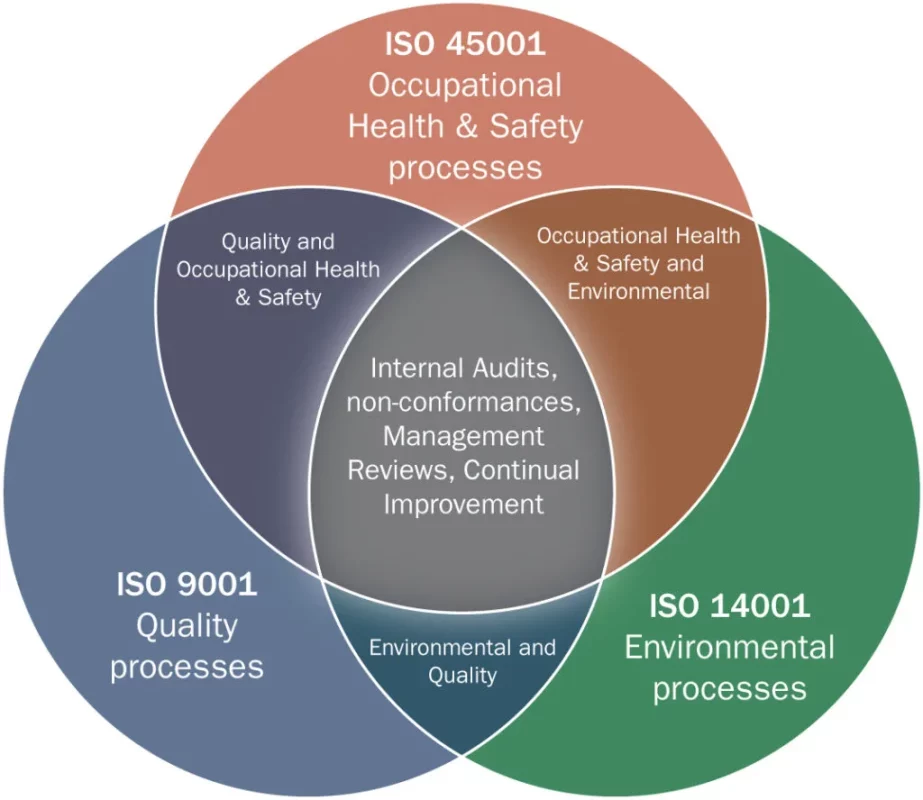Table of Contents
In today’s complex business environment, organizations face the challenge of managing multiple standards for quality, environmental impact, health and safety, information security, and more. An Integrated Management System (IMS) provides a powerful solution by merging these diverse standards into a single, cohesive framework. This article delves into what an IMS is, its benefits, core components, and how to implement one effectively.
What is an Integrated Management System (IMS)?
An IMS is a comprehensive management system that aligns multiple management system standards like ISO 9001 (Quality), ISO 14001 (Environment), ISO 45001 (Occupational Health and Safety), and ISO 27001 (Information Security). This integration streamlines operations, eliminates redundancies, reduces costs, and simplifies compliance across various areas.
Benefits of an Integrated Management System IMS
- Improved Efficiency and Performance: An IMS consolidates processes, reducing duplication and enabling better resource allocation. This leads to increased efficiency and improved performance across the organization.
- Enhanced Compliance: An IMS simplifies compliance with multiple standards by providing a centralized system for managing requirements.
- Better Decision-Making: An IMS offers a holistic view of the organization’s operations, enabling more informed decision-making that considers quality, environmental, safety, and other factors.
- Increased Customer Satisfaction: By ensuring consistent quality and addressing environmental and safety concerns, an IMS contributes to improved customer satisfaction.
- Reduced Operational Costs: An IMS minimizes the need for separate audits, certifications, and documentation, resulting in lower operational costs.
- Stronger Risk Management: An IMS promotes a proactive approach to risk identification and mitigation across all management areas.

Key Components of an Integrated Management System IMS
- Quality Management System (QMS): A QMS focuses on meeting customer requirements and ensuring product and service quality.
- Environmental Management System (EMS): An EMS helps organizations manage their environmental impact and comply with regulations.
- Occupational Health and Safety Management System (OHSMS): An OHSMS protects the health, safety, and welfare of employees and stakeholders.
- Information Security Management System (ISMS): An ISMS safeguards sensitive data and ensures information security.
- Other Potential Components: An IMS can include additional standards like Business Continuity Management Systems (BCMS) and Energy Management Systems (EnMS).
How to Implement an Integrated Management System IMS?
- Initial Assessment: Thoroughly analyze your existing management systems and identify areas for integration.
- IMS Development: Create a unified framework that aligns the requirements of chosen standards.
- Training and Communication: Educate employees about the IMS, their roles, and its benefits. Emphasize strong communication throughout.
- Implementation: Integrate the IMS into your daily operations and adapt existing processes accordingly.
- Monitoring and Review: Conduct regular audits and reviews to evaluate IMS effectiveness and identify areas for improvement.
- Certification (Optional): Consider obtaining IMS certifications to demonstrate your commitment to quality, environmental responsibility, safety, and other standards.
Integrated Management System and Digital Transformation
- Software Solutions: Implement specialized IMS software for streamlined management, document control, and analytics.
- Automation: Automate repetitive tasks within your IMS to save time and improve accuracy.
- Data Analytics: Leverage insights from IMS data to make better decisions and identify improvement opportunities.
Conclusion
An Integrated Management System provides a powerful framework for organizations seeking to optimize operations, improve performance, and simplify compliance across multiple disciplines. By understanding the components, benefits, and implementation steps of an IMS, you can set your organization on the path to a more efficient and streamlined future.
Frequently Asked Questions
what is integrated management systems?
An integrated management system (IMS) is a framework that combines multiple management system standards into one cohesive system. This allows organizations to streamline operations, eliminate redundancies, reduce costs, and simplify compliance across various areas. Common management systems integrated into an IMS include quality (ISO 9001), environment (ISO 14001), and health and safety (ISO 45001).
what integrates a company’s existing management information systems?
An IMS integrates various management systems a company already has in place. For instance, an organization might have separate systems for managing quality control, environmental impact, and employee safety. An IMS would merge these systems into a unified framework, ensuring consistent policies and procedures across the board.
what is integrated quality management system?
An integrated quality management system is a specific type of IMS that focuses on quality control across all aspects of an organization’s operations. It ensures that products and services meet customer requirements and that there is a continuous process of improvement.
what is integrated safety management system?
An integrated safety management system is another type of IMS that specifically focuses on occupational health and safety. It helps organizations identify and mitigate risks, prevent accidents, and create a safe working environment for employees.
what is integrated security management system?
An integrated security management system combines various security measures into one framework. This can include physical security, information security, and operational security.
what is iso integrated management system?
ISO (International Organization for Standardization) publishes a number of standards that can be integrated into an IMS. Common standards include ISO 9001 (Quality), ISO 14001 (Environment), ISO 45001 (Occupational Health and Safety), and ISO 27001 (Information Security).
which tool enables the deployment of integrated quality management system?
There’s no single tool that facilitates the deployment of an integrated quality management system. However, specialized IMS software can streamline management, document control, and data analysis for an IMS.
what is an integrated business management system?
An integrated business management system (IBMS) is a type of IMS that incorporates a broader range of business functions beyond the typical quality, environment, and safety focus. An IBMS may include areas like customer relationship management, supply chain management, and financial management.
what is an integrated management system?
An integrated management system (IMS) is a framework that combines multiple management system standards into one cohesive system. This allows organizations to streamline operations, eliminate redundancies, reduce costs, and simplify compliance across various areas.
what is the purpose of integrated management system?
The purpose of an integrated management system is to streamline operations, improve efficiency, reduce costs, and simplify compliance across multiple disciplines. An IMS achieves this by integrating various management systems a company already has in place into a unified framework. This promotes a holistic approach that considers quality, environmental impact, safety, and other factors in decision-making.
